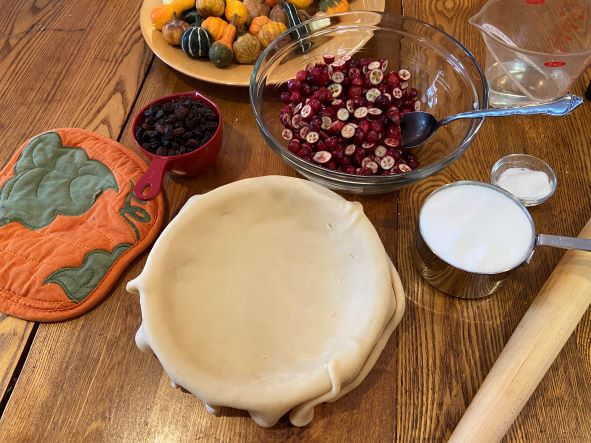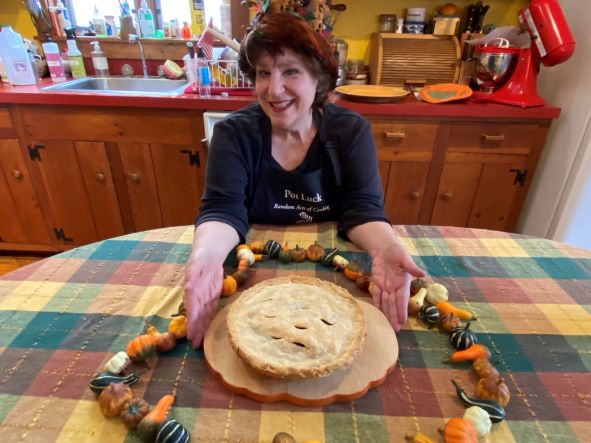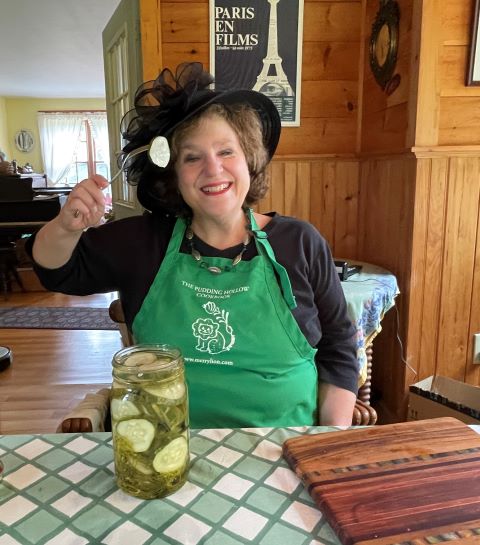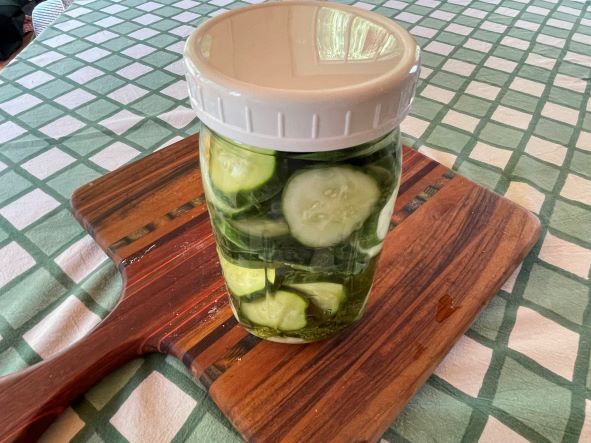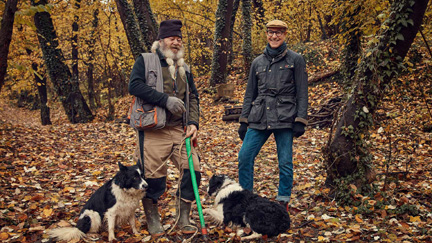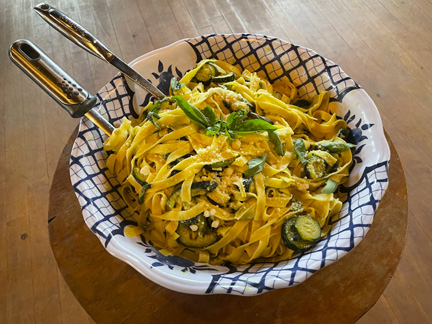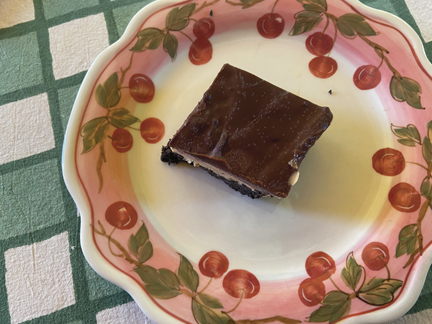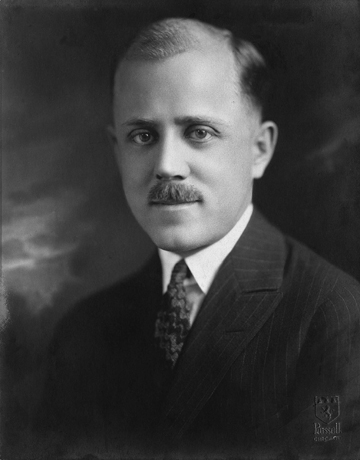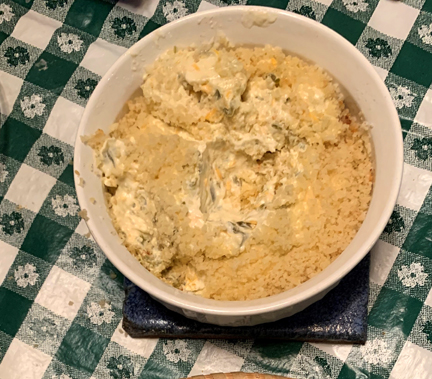
Dennis’s Dip
My birthday falls next week, just two days before Christmas. In recent years, my family has instituted a birthday tradition for me that I adore. We eat only appetizers and desserts—or rather dessert, since the dessert du jour is always birthday cake for me.
If I didn’t feel that I should worry about my health, I would eschew main courses and eat nothing but appetizers and desserts all the time; I’m not a big fan of main courses. (Or perhaps I wouldn’t. After all, the appeal of this meal is that it isn’t ordinary.)
I got the idea from my neighbors at Singing Brook Farm here in Hawley, Massachusetts, who celebrate “Appy Night” every year the night after Thanksgiving. They know that the Thanksgiving table revolves around the turkey and its accoutrements, and they relish that special meal.
The evening AFTER Thanksgiving, however, they pay tribute to foods that don’t get to star on Thanksgiving and devote themselves to sumptuous appetizers and desserts.
I asked my friends and honorary cousins Molly and Liza Pyle how this tradition began. “It was during the Gam era,” Molly informed me. Gam was Mary Parker, the family’s much beloved (and occasionally much feared) matriarch. She died in 1989 so we calculated that Appy Night was born at least 35 years ago.
Thanksgiving was always the biggest annual holiday in the Singing Brook Farm family. As Gam’s grandchildren grew up and got married, they and their spouses prepared more and more elaborate dishes for the big meal.
One year in the 1980s, they went crazy with appetizers. When it came time to carve the turkey, no one had any appetite for it.
“And Gam was NOT happy,” Liza recalled. I shuddered mentally, remembering all too well that an unhappy Gam made for an unhappy family and an unhappy neighborhood.
The following year Appetizer Night entered the world, giving the family a chance to cook and consume foods that complemented the Thanksgiving board without overwhelming it, i.e. appetizers and desserts.
The practice also extends the holiday to more family members. Liza noted, “Often people arrive who can’t come the day before. It’s an opportunity to have that family connection.”
“And to contribute,” said her husband Dennis Bowen. The family is composed of a lot of active, competitive cooks who live to share their culinary talents.
The evening is relaxed. Not everything has to be served at once since the feast can last for hours. Food can arrive whenever it arrives.
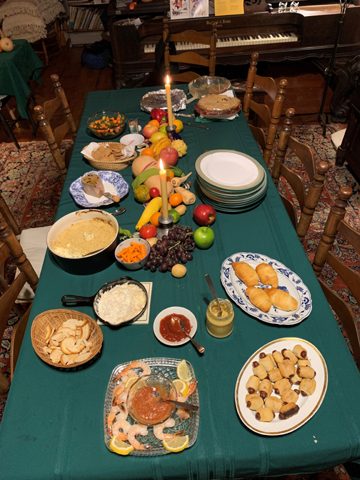
This Year’s Appy Night First Course
I asked the family to identify some memorable dishes they had consumed during Appy Nights in the past. Liza and Molly’s brother David recalled a long-ago dish of baked bacon coated with brown sugar. Everyone was crazy about one sibling’s ex-wife’s rich crab dip. (I’m pursuing that recipe for the future.)
The gang seemed to agree that Dennis’s jalapeño dip was a perennial favorite, however. So that’s the recipe I’m sharing today.
The dip is considerably spicier the day after Dennis makes it, I am told. For some people, this will represent a warning; for others, a promise.
Appy Night usually includes some kind of salad as well as all the goodies, “for sanity’s sake,” Liza informed me. This year she threw together a Caesar salad. And of course there are myriad pies and sometimes other sweets.
The “dish” Singing Brook Farm’s current matriarch, Alice, enjoyed the most at this year’s gathering wasn’t actually edible. It was her newest great grandson, baby Jackson.
Thanksgiving is over for this year—but I encourage readers to try the appetizer-and-dessert model for other holiday parties.
It would work beautifully on Christmas Eve or New Year’s Day … or on one of those evenings during Hanukkah or Kwanzaa when the family doesn’t want a big meal but still wants to celebrate a little. It would also work as a fun pot-luck format for entertaining at any time of the year.
Here is Dennis’s dip. I have a feeling it will appear on my birthday menu. Thanks to Molly Pyle Stejskal for the photos in this post!
And by the way, if you’re searching for a holiday gift, remember a cookbook makes a lasting one. There’s still time to ship them before Christmas! Mine can be purchased here:
https://tinkycooks.com/tinkys-books/
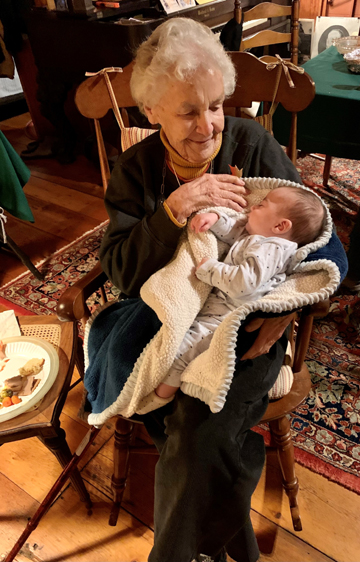
Alice with Little Jackson Santini
Dennis’s Jalapeño Dip
I should note that Liza and Dennis disagree on the proportions in this dip. Liza finds the topping a bit much and would prefer to reduce it by a quarter (to 3/4 cup crumbs, 6 tablespoons cheese, 3 tablespoons melted butter). Dennis likes it just the way it is, however.
Ingredients:
for the dip:
2 8-ounce bricks cream cheese, at room temperature
1 cup mayonnaise
1 cup shredded cheese (a Mexican blend or even a nice sharp cheddar)
1/2 cup grated Parmesan cheese
1 can (4.5 ounces) green chiles, undrained
4 ounces pickled jalapeño peppers, rinsed and finely chopped
1 fresh jalapeño, finely chopped
for the topping:
1 cup panko bread crumbs
1/2 cup grated Parmesan cheese
4 tablespoons (1/2 stick) melted butter
Instructions:
Preheat the oven to 375 degrees. Grease a pie pan or a medium-size baking dish. Combine the dip ingredients thoroughly; then spoon the mixture into the prepared pan.
In another bowl, combine the topping ingredients until they are well blended. Sprinkle the crumb mixture evenly over the top of the dip. Bake until the dip is bubbly and the top browns, about 20 minutes.
The Singing Brook Farmers served the dip with large wheat crackers and carrot sticks this year. “But whatever!” said Liza. Serves a crowd.
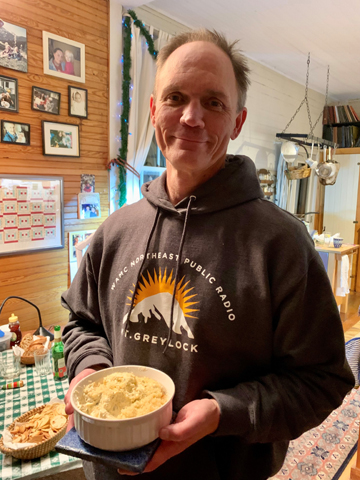
Dennis with His Dip
